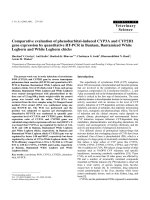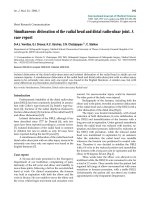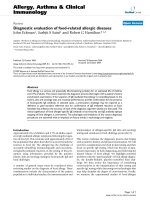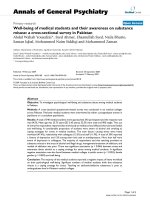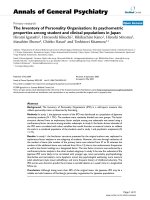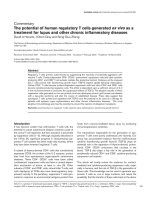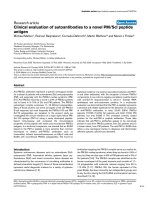Báo cáo y học: "Comparative evaluation of left ventricular mass regression after aortic valve replacement: a prospective randomized analysis" pptx
Bạn đang xem bản rút gọn của tài liệu. Xem và tải ngay bản đầy đủ của tài liệu tại đây (490.15 KB, 8 trang )
RESEARCH ARTICLE Open Access
Comparative evaluation of left ventricular mass
regression after aortic valve replacement:
a prospective randomized analysis
Mirko Doss
*
, Jeffrey P Wood, Arndt H Kiessling and Anton Moritz
Abstract
Background: We assessed the hemodynamic performance of various prostheses and the clinical outcomes after
aortic valve replacement, in different age groups.
Methods: One-hundred-and-twenty patients with isolated aortic valve stenosis were included in this prospective
randomized randomised trial and allocated in three age-groups to receive either pulmonary autograft (PA, n = 20)
or mechanical prosthesis (MP, Edwards Mira n = 20) in group 1 (age < 55 years), either stentless bioprosthesis (CE
Prima Plus n = 20) or MP (Edwards Mira n = 20) in group 2 (age 55-75 years) and either stentless (CE Prima Plus n
= 20) or stented bioprosthesis (CE Perimount n = 20) in group 3 (age > 75). Clinical outcomes and hemodynamic
performance were evaluated at discharge, six months and one year.
Results: In group 1, patients with PA had significantly lower mean gradients than the MP (2.6 vs. 10.9 mmHg, p =
0.0005) with comparable left ventricular mass regression (LVMR). Morbidity included 1 stroke in the PA population
and 1 gastrointestinal bleeding in the MP subgroup. In group 2, mean gradients did not differ significantly
between both populations (7.0 vs. 8.9 mmHg, p = 0.81). The rate of LVMR and EF were comparable at 12 months;
each group with one mortality. Morbidity included 1 stroke and 1 gastrointestinal bleeding in the stentless and 3
bleeding complications in the MP group. In group 3, mean gradients did not differ significantly (7.8 vs 6.5 mmHg,
p = 0.06). Postoperative EF and LVMR were comparable. There were 3 deaths in the stented group and no
mortality in the stentless group. Morbidity included 1 endocarditis and 1 stroke in the stentless compared to 1
endocarditis, 1 stroke and one pulmonary embolism in the stented group.
Conclusions: Clinical outcomes justify valve replacement with either valve substitute in the respective age groups.
The PA hemodynamically outperformed the MPs. Stentless valves however, did not demonstrate significantly
superior hemodynamics or outcomes in comparison to stented bioprosthesis or MPs.
Keywords: Left Ventricular Mass, Aortic Valve Replacement, Prospective randomized Analysis
Background
Aortic stenosis is the predominant lesion in the majority
of patients presenting with clinically significant aortic
valve disease. The only definitive treatment of critical
aortic stenosis is aortic valve replacement (AVR).
Indecidingthechoiceofprosthesisinsimpleaortic
valve replacement, most surgeons recommend a
mechanical valve in the younger pa tients and a stented
bioprosthesis in older individuals. Within the last
decade, pulmonary autografts and stentless bioprosthesis
have been established as alternatives to mechanical
valves and stented bioprosthesis, respectively. The pre-
cise age at which one prosthesis is preferred over the
other is a matter of controversy, but recent studies indi-
cate that patients over the age of 65 years should receive
a bioprost hesis (stented or stentless) and patients whose
life expectancy is at least 15 years should receive a
mechanical valve [1]. The latter group of patients would
alternatively be eligible for a pulmonary autograft. Stent-
less valves with their unique design features, that allow
laminar flow resulting in less stress on leaflets, promise
* Correspondence:
Department of Thoracic and Cardiovascular Surgery, Johann Wolfgang
Goethe University, Frankfurt am Main, Germany
Doss et al. Journal of Cardiothoracic Surgery 2011, 6:136
/>© 2011 Doss et al; licensee BioMed Central Ltd. This is an Open Access article distributed under the terms of the Creative Commons
Attribution License ( which permits unrestricted use, distribution, and reproduction in
any medium, provided the original work is properly cited.
an even longer freed om from structural valve deteriora-
tion than stented bioprosthesis.
We can therefore identify a third group of p atients,
between the ages of 55-75 years that would be eligible
for either a stentless bioprosthesis or a mechanical
valve. Any evaluation of optimal prostheses cannot be
based on durability data alone, and must include hemo-
dynamic assessment and clinical performance of the
valvular substitutes, judged according to the “guidelines
for reporting morbidity and mortali ty after cardiac valv-
ular operations.”[2].
Regression of LV-hypertrophy after AVR, being one of
the key determinants of postoperative morbidity and
mortality, has been under investigation by many groups
in the field. The literature provides extensive documen-
tation on non randomized assessment of mechanical
and bioprosthesis, with regards to LV mass regression.
However, few prospective randomized clinical studies
are reported.
Theaimofthecurrentstudywastoprovidesome
rationale to select the optimal valve substitute, for a cer-
tain age group, based on valve performance and its
effects on regression of LV hypertrophy in a prospect ive
randomized setting.
Methods
One-hundred and twen ty patients undergoing elective
aortic valve replacement were entered in this prospec-
tive evaluation. Dependent on their age, they were allo-
cated into tree groups. Patients in group I were less
than 55 years of age and were randomized to receive
either a mechanical (Edwards Mira, n = 20) or a pul-
monary autograft (n = 20). Patients in group II were
between 55-75 years old and were randomized for a
stentless bioprosthesis (CE Prima Plus, n = 20) or a
mechanical valve (Edwards M ira, n = 20). Patients in
group III were above the age of 75 years and were ran-
domly assigned to a stentless bioprosthesis (CE Prima
Plus, n = 20) or a stented bio prosthesis (CE Perimount,
n = 20). All patients underwent preoperative and post-
operative transthoracic echocardiography (at discharge,
6 and 12 months) for functional and structural assess-
ment. All clinical and echocardiographic data describing
this population were prespecified and collected post-
operatively. A valvular d atabase, provided by Edwards
Lifesciences, was used to collect preoperative, periopera-
tive and postoperative patient information. The study
protoc ol was approved by our institutional ethics review
board. All patients provided written informed consent
before entering the study.
The choice of valve prosthesis was made preopera-
tively and feasibility of implantation was confirmed
intraoperatively. Severe calcification of the aortic root
diagnosed intraoperatively, very low position of coronary
ostia in relati on to the annulus and atypical insertion of
the coronary ostia made it impossible to implant stent-
less valves or pulmonary autografts.
Preoperative transthoracic echocardiography was used
to identify patients in whom the use of stentless valves
and pulmonary autografts seemed safe. The sizes of
both the nativ e aorta and at the level of the sinotub ular
junction and the annulus were measured. If the dia-
meter of the annulus was found to be larger than or less
than the size of the sinotubular junction by more than 2
valve sizes (i.e. 4 mm), patients were excluded from the
study. Patients with a subvalvular pressure gradient,
active endocarditis and the ne ed for concomitant valvu-
lar surgery were similarly excluded from enrolment.
(Figure 1)
Operative technique
Access to the heart was gained via median sternotomy.
Standard extracorporeal circulation with moderate
hypothermia (28°C) was used. All patients had antegrade
and retrograde cold blood cardioplegia and carbon diox-
ide insufflation of the open thorax for organ protection.
All pulmonary autograft procedures were performed
as root replacements with implantation of the coronary
arteries on the graft. Reconstruction of the right ventri-
cular outflow tract was performed with cryopreserved
pulmonary valve homografts in all patients.
The Prima Plus stentless bioprosthesis were implanted
in the subcoronary position. The aortic valve was
exposed via a transverse aortotomy. After resection of
the native aortic valve and debridement of the aortic
annulus, accurate sizing was carried out using the
respective seizers. The commissures were positioned
120° apart with the muscular shelf corresponding to the
right coronary sinus. Single interrupted unpledgeted 4-0
Ethibond sutures were used for the proximal end and
the rims o f the valve commissures were sutured to the
native aorta using 4-0 polypropylene running sutures.
FortheMiramechanicalaorticvalvesandthePeri-
mount stented bioprosthesis access to the aortic valve
was gained via a hockeystick aortotomy. The valves
were implanted in the supraannular position. Inter-
rupted mattressed pledgeted 2-0 Ethibo nd sutures were
placed circumferentially from below the annulus.
Mechanical valves were oriented in the antia natomical
position.
Echocardiography
Two experienced operators performed all echocardio-
grams for the study on a standard machine (System
Five, Sonotron Vingmed). Cardiac morphology and
function as well as hemodynamic parameters were
assessed. All hemodynamic measurements were per-
formed with patients in stable conditions. Aortic valve
Doss et al. Journal of Cardiothoracic Surgery 2011, 6:136
/>Page 2 of 8
flow velocities were assessed with continuous wave Dop-
pler. End diastolic left ventricular posterior wall thick-
ness > 12 mm was considered hypertrophied. Aortic
valve incompetence was judged as transvalvular or para-
valvular and graded according to the regurgitant jet area
in relation to left ventricle as mild, moderate or s evere.
Apart from standard imaging views, preoperative echo-
cardiography also included the measurement of the dia-
meter of the native aortic annulus and the sinotubular
junction as well as the assessment of subvalvular gradi-
ents, in order to identify a possible mismatch between
annulus and sinotubular juncti on or excessive subvalvu-
lar hypertrophy. Both conditions would render the
patient unsuitable for the study.
Follow up
Follow up examinations were scheduled for discharge
from the h ospital, at six and 12 months postoperatively.
All patients were subject to detailed clinical and echocar-
diographic follo w-up. This included the New York Heart
Association functional class (NYHA), blood data including
signs of haemolysis, anticoagulation profile, assessment of
cardiac rhythm and blood pressure and documentation of
occurrence of early and late complications.
In echocardiography follow-up, our special attention
was focused on the regression of LV-hypertrophy. Both
completeness and rate of LV-mass regression ware
assessed. In addition, changes in LV-function and hemo-
dynamics including effective orifice area (EOA), as well
as changes in postoperative transvalvular gradients were
analyzed.
Anticoagulation regime
Our anticoagulation regime was as follows . Patients with
pulmonary autografts did not receive oral anticoagula-
tion. Patients with bioprosthesis had oral anticoagulation
for 3 months and patients with mechanical valves had
lifelong anticoagulation.
Our protocol included subcutaneous low molecular
heparin for the first day and parallel oral anticoagulation
Figure 1 Recruitment flow chart.
Doss et al. Journal of Cardiothoracic Surgery 2011, 6:136
/>Page 3 of 8
with vitamin K antagonists. As soon as the International
Normalized Ration (INR) levels reached the therapeutic
target range of 2.5 - 3.5, the heparin was discontinued.
Initially, oral anticoagulation was monitored by the
patient’ s general practitioners. However, most patients
who received mechanical valves soon attended a struc-
tured course on oral anticoagulation self management,
and henceforth monitored their own INR levels, using
the portable CoaguCheck™ (Roche Diagnostics) device.
Statistical methods
All data were compiled and analyzed using Microsoft
Access, Microsoft Excel (Redmont WA) and StatView
(Cary, NC). The baseline characteristics and hospital
outcomes for the two groups were compared using chi-
square or Fisher’ s exact test for categorical data and
unpaired t-tests for continuous variables. Results are
reported as mean ± standard deviation in text and
tables. Statistical significance was defined as a p value
less than 0.05.
Results
Patients were allocated according to their age and there-
fore results are reported separately for the respective
age groups.
Group I (pulmonary autograft vs. mechanical valve
replacement, age < 55 years)
The two patient groups were comparable with regards
to preoperative demographic data and clinical character-
istics (table 1). Cross-clamp times and total cardiopul-
monary bypass times were significantly longer in the
pulmonary autograft group. A summary of intraopera-
tive outcomes is given in Table 2. There were no
intraoperative deaths and all patients were transferred to
the i ntensive care unit in stable conditions. Rethoracot-
omy for bleeding had to be performed in 3 patients, all
in the mechanical group. None of these patients
required prolonged mechanical ventilation and had an
uneventful recovery.
There were no perioperative deaths in either group
and all patients were discharged from hospital. At fol-
low-up, t wo late deaths had occurred in the pulmonary
autograft group. Both pati ents died at home and sudden
death was suspected by the general practitioner,
although the cause of death was not confirmed at
autopsy. There was one late death in the mechanical
valve group. After being admitted to hospital due to
pneumonia this patient required intubation and
mechanical ventilation. Eventually the patient died o f
sepsis.
Another two patients in the pulmonary autograft
group required reoperation for aortic root dilatation and
subsequent severe aortic regurgitation. Both patients
received mechanical heart valves 7 and 11 months after
their initial procedure.
There was one anticoagulation-related complication in
the mechanical valve group. The patien t had a gastroin-
testinal bleeding and required hospitalisation. One
patientinthepulmonaryautograftgroupsuffereda
stroke 6 months after surgery. At the time he was in
sinus rhythm and underwent an intensive search for
what might have caused this stroke. However, other
than his recent aortic valve surgery, no other risk factors
couldbeidentified.Therewerenoothervalverelated
complications in this group. Hemodynamic performance
was significantly better in the pulmonary autograft
group. The LV mass regression howev er did not differ
Table 1 Preoperative patient characteristics
ROSS
n=20
MIRA
n=20
PRIMA PLUS
n=20
MIRA
n=20
PRIMA PLUS
n=20
PERI- MOUNT
n=20
Female 8 9 11 10 9 12
Male 12 11 9 10 11 8
Age (years) 49 ± 8.3 48 ± 6.9 60 ± 4.1 62 ± 2.3 78 ± 3.8 79 ± 4.3
BSA (m
2
) 1.82 ± 0.7 1.89 ± 0.4 1.76 ± 0.2 1.67 ± 0.2 1.79 ± 0.6 1.85 ± 0.8
Hypertension 7 6 9 8 10 9
Atrial fibrillation 0 1 0 0 0 1
Mean gradient (mmHg) 56.6 ± 12.6 59.4 ± 16.2 49.0 ± 20.0 52.0 ± 18.0 58.1 ± 18.2 50.9 ± 14.8
IVS (cm) 1.98 ± 0.2 1.82 ± 0.4 1.95 ± 0.3 1.97 ± 0.2 1.94 ± 1.9 1.91 ± 0.9
LVW (cm) 1.95 ± 0.3 1.81 ± 0.2 1.99 ± 0.5 2.01 ± 0.4 1.93 ± 0.3 1.98 ± 0.2
LVEDD (cm) 4.9 ± 0.5 4.7 ± 0.3 4.6 ± 0.3 4.8 ± 0.3 4.8 ± 0.4 4.6 ± 0.3
LVESD (cm) 3.7 ± 0.4 3.4 ± 0.3 3.6 ± 0.2 3.9 ± 0.4 3.2 ± 0.3 3.5 ± 0.2
PEF EF (%) 66.3 ± 7.9 67.2 ± 6.8 62.0 ± 7.0 65.0 ± 6.0 65.9 ± 7.4 66.6 ± 8.6
NYHA III-IV 16 16 17 15 17 18
Concomitant CABG 0 2 0 0 2 3
Doss et al. Journal of Cardiothoracic Surgery 2011, 6:136
/>Page 4 of 8
significantly between the groups. All echocardiographic
data regarding regression of LV mass, ejection fraction,
transvalvular gradients and effec tive orifice area are
summarized in table 3.
Group II (stentless bioprosthesis vs. mechanical valve
replacement, age 55-75 years)
Again, the two patient groups were comparable in clin-
ical characteristics and preoperative demographics data
(table 1). The cross-clamp and cardiopulmonary bypass
times were longer in the stentless valve group. The
intraoperative outcomes are listed in table 2. There
were no intraoperative deaths. Early postoperative, one
patient in the stentless va lve group, died of a major
hemorrhage, on the intensive care ward. He required
tracheotomy due to prolonged ventilation and devel-
oped fatal intratracheal bleeding. In the mechanical
valvegrouptherewerenoearly,butonelatedeath.At
6 months postoperatively the patient had a gastroin-
testinal bleeding and died before reaching the hospital.
Rethoracotomy for bleeding had to be performed in
one patient in the stentless valve group, due to cardiac
tamponade. All other patients had an uneventful
recovery and were discharged from hospital. At follow
up, there was one additio nal gastrointestinal bleeding
complication in the mechanical valve group. One
patient in this group developed a mild paravalvular
leak. He rema ins under close observation by his cardi-
ologist and so far no significant hemolysis or increase
in regurgitation has occurred. At 8 months postopera-
tively, one patient in the stentless valve group suffered
a stroke. There were no other valve related complica-
tionsinthisgroup.
Echocardiographic evaluation showed no significant
difference in hemodynamic performance or rate and
extent of LV-mass regression between the groups. All
relevant data are summarized in table 3.
75 years)",1,0,1,0,0pc,0pc,0pc,0pc>Group III (stentless vs.
stented bioprosthesis, age > 75 years)
Demographic data and clinical characte ristics were com-
parable between the groups (table 1). The cross-clamp
and total cardiopulmonary bypass times were signifi-
cantly longer in the stentless valve group. There were
two n ot-valve related early deaths (pneumonia, septice-
mia) and one late death (rupt ured abdominal aortic
aneurysm) in the stented valve group. The other intra-
and postoperative outcomes were comparable between
the groups. One patient in each group suffered a stroke.
There was one anticoagulation-relat ed bleeding compli-
cation during the early postoperative phase in the
stented valve group. One patient in each group devel-
oped endocarditis and were reoperated.
Echocardiographic evaluation at discharge, 6 and 12
mont hs postoperatively, again did not reveal any signifi-
cant differences in the rate an d completeness of LV
mass regression. The hemodynamic performance of the
two bioprosthesis was comparable, with regards to mean
transvalvular gradi ent, effective orifice area and ejection
fraction. All relevant data are shown in table 3.
A summary of clinical status at the follow up exami-
nation is given in table 4.
Discussion
Although AVR can be performed with low perioperative
and postoperative risk, the optimal substitute for the
native aortic valve has not been found. A significant
postoperative regression of hypertrophy and improve-
ment in LV-function is achieved by most prostheses.
However residual LV-hypertrophy is common after AVR
Table 2 Intraoperative outcomes
ROSS
n=20
MIRA
n=20
PRIMA PLUS
n=20
MIRA
n=20
PRIMA PLUS
n=20
PERI- MOUNT
n=20
Cross-clamp time (min) 111 ± 21 75 ± 19 102 ± 22 76 ± 24 108 ± 17 79 ± 17
CPB time (min) 141 ± 37 102 ± 23 128 ± 26 104 ± 19 130 ± 19 105 ± 23
Implantation technique full root supraannular subcoronary supraannular subcoronary supraannular
Subaortic stenosis 0 0 0 0 0 0
Mean annular diameter (mm) 25 ± 3.6 22 ± 1.6 22.4 ± 1.9 22.9 ± 1.8 21.2 ± 1.6 20.6 ± 1.9
Mean valve size implanted (mm) 24.9 ± 2.3 24.2 ± 1.7 24.1 ± 1.8 24.8 ± 1.5 23.9 ± 1.8 22.8 ± 1.9
Valve Size (mm)
2100504 6
23 6 11 7 10 9 10
2589576 4
2730331 0
2920000 0
Doss et al. Journal of Cardiothoracic Surgery 2011, 6:136
/>Page 5 of 8
and impairs LV diastolic function which can lead to late
congestive cardiac failure. He and colleagues reported
on a cohort of patients where incomplete regression o f
LV hypertrophy significantly reduced 10 year survival
[3]. Unresolved LV hypertrophy not only increases mor-
tality but also compromises quality of life and increases
morbidity [4]. Michel and colleagues, showed an
increased incidence and severity of ventricular
Table 4 Clinical status at 12 months postoperatively
ROSS
n=20
MIRA
n=20
PRIMA PLUS
n=20
MIRA
n=20
PRIMA PLUS
n=20
PERI- MOUNT
n=20
NYHA I - II n = 20 n = 20 n = 18 n = 17 n = 18 n = 16
NYHA III - IV n = 0 n = 0 n = 1 n = 2 n = 2 n = 1
Mean systolic RR (mmHg) 129 ± 21 123 ± 19 128 ± 15 135 ± 16 132 ± 15 136 ± 18
Sinus rhythm n = 20 n = 18 n = 18 n = 19 n = 18 n = 15
Atrial Fibrillation n = 0 n = 2 n = 1 n = 0 n = 2 n = 2
Mortality n = 2 n = 1 n = 1 n = 1 n = 0 n = 3
SAE n=2 n=1 n=1 n=2 n=2 n=3
Table 3 Echocardiographic findings
ROSS
n=20
MIRA
n=20
PRIMA PLUS
n=20
MIRA
n=20
PRIMA PLUS
n=20
PERI-MOUNT
n=20
Mean gradient (mmHg)
Preoperative 56.6 ± 12.6 59.4 ± 16.2 49.0 ± 20 52.0 ± 18 58.1 ± 18.2 50.9 ± 14.8
6 months 3.2 ± 1.7 9.3 ± 4.5 9.3 ± 6.9 10.2 ± 5.4 8.4 ± 3.6 7.3 ± 3.7
12 months 2.6 ± 1.3 9.3 ± 3.6 7.0 ± 4.7 8.9 ± 6.1 7.4 ± 4.9 6.6 ± 2.3
p-value p = 0.005 p = NS p = NS
Effective Orifice Area (cm
2
)
preoperative 0.71 ± 0.3 0.82 ± 0.2 0.85 ± 0.4 0.79 ± 0.3 0.87 ± 0.4 0.76 ± 0.3
6 months 2.10 ± 0.5 1.61 ± 0.4 1.70 ± 0.5 1.68 ± 0.4 1.63 ± 0.4 1.51 ± 0.6
12 months 2.50 ± 0.6 1.81 ± 0.3 1.91 ± 0.7 1.84 ± 0.5 1.83 ± 0.6 1.92 ± 0.8
p-value p = 0.005 p = NS p = NS
EF (%)
preoperative 66.3 ± 7.9 67.2 ± 6.8 62.1 ± 7.2 65.0 ± 6.1 65.9 ± 7.4 66.6 ± 8.6
6 months 66.4 ± 8.3 65.8 ± 7.8 65.4 ± 6.9 64.3 ± 7.2 67.6 ± 8.7 66.2 ± 10.5
12 months 67.5 ± 8.1 65.0 ± 10.7 66.9 ± 8.1 65.9 ± 6.8 66.6 ± 8.1 64.7 ± 11.2
p-value p = NS p = NS p = NS
Left Ventricular Posterior Wall Thickness (cm)
preoperative 1.95 ± 0.3 1.81 ± 0.2 1.99 ± 0.5 2.01 ± 0.4 1.93 ± 0.3 1.98 ± 0.2
6 months 1.53 ± 0.3 1.45 ± 0.1 1.61 ± 0.3 1.65 ± 0.2 1.63 ± 0.2 1.66 ± 0.1
12 months 1.32 ± 0.2 1.24 ± 0.2 1.28 ± 0.2 1.24 ± 0.2 1.26 ± 0.2 1.32 ± 0.2
p-value p = NS p = NS p = NS
Interventricular Septum Thickness (cm)
preoperative 1.98 ± 0.2 1.82 ± 0.4 1.95 ± 0.3 1.97 ± 0.2 1.94 ± 1.9 1.91 ± 0.9
6 months 1.70 ± 0.2 1.60 ± 0.2 1.60 ± 0.2 1.69 ± 0.3 1.54 ± 0.2 1.51 ± 0.2
12 months 1.34 ± 0.1 1.24 ± 0.1 1.29 ± 0.3 1.32 ± 0.2 1.24 ± 0.3 1.28 ± 0.2
p-value p = NS p = NS p = NS
Left Ventricular Mass Index (g/m
2
)
preoperative 185 ± 42.3 179 ± 38.6 181 ± 40.9 182 ± 39.2 174 ± 34.3 180 ± 40.5
6 months 149 ± 34.1 141 ± 35.4 143 ± 34.2 145 ± 32.8 130 ± 31.0 132 ± 36.1
12 months 114 ± 27.2 110 ± 30.2 109 ± 29.3 111 ± 27.6 104 ± 28.5 106 ± 32.5
p-value p = NS p = NS p = NS
Doss et al. Journal of Cardiothoracic Surgery 2011, 6:136
/>Page 6 of 8
arrhythmias in patients with LV hypertrophy after aortic
valve replacement [5]. Persistent hypertrophy may be
due to the obstructive nature of the valve itself, host
related factors or due to patient prosthesis mismatch.
Valve-related left ventricular pressure increase is an
important reason for incomplete regression of cellular
hypertrophy and the development of increased intersti-
tial fibrosis postoperatively [6].
Therefore, one could argue that to achieve an optimal
postoperative result, prosthesis has to be chosen that
incorporates least obstructiveness with best hemody-
namic performance. We would expect a subsequent fas-
ter and more complete regression of LV-hypertrophy
with the use of such prostheses. Based on valve perfor-
mance and its effects on regression of LV-hypertrophy,
the current study was designed to provide some ratio-
nale to select the optimal valve substitute for patients in
a certain age group.
The beneficial effe cts of a less obstructive valve (pul-
monary autografts, stentless valves) have often been
demonstrated [7-10]. However, in the case of pulmonary
autografts there are none, and for stentless valves there
are only four randomized trials, comparing their perfor-
mance to more obstructive valves (stented biop rosthesis,
mechanical valves).
In our study, the pulmonary autografts had signifi-
cantly lower transvalvular gradients than the mechanical
valves. From our understanding of the pathophysiology
of aortic valve stenosis, we would have expected a signif-
icant difference in the regression of left ventricular
hypertrophybetweenthetwovalvesubstitutes.How-
ever, in this randomized group of patients, left ventricu-
lar mass regression was similar in both groups at 6 and
12 months, despite the superior hemodynamic perfor-
mance of the pulmonary autografts. Significant regres-
sion of left ventricular hypertrophy has been reported in
literature after aortic valve replacement with both sub-
stitutes [10-13]. The 12 month postoperative follow-up
period, also seems to be sufficient to assess the regres-
sion of left ventricular hypertrophy. Several authors
have demonstrated that no difference in left ventricular
mass regression is found between 1 year and 3 years of
follow up [9,13,14]. At this point one can ask if the sta-
tistical difference in transvalvular gradients was clinically
relevant. Considering that a peak systolic gradient of up
to 20 mmHg can be considered physiologic, we noted
that in both groups the peak gradients lay below the 20
mmHg m ark (pulmonary a utografts 4.8 mmHg and
mechanical valves 16.2 mmHg). Interestingly, Walter
and colleagues reported a significant difference in the
rate of left ventricular mass regression in patients with
peak transvalvular pressure gradients of 16.7 mmHg
after stentless versus 20.1 mmHg after stented aortic
valve replacement, in a randomized cohort of 180
patients [15]. In group II (mechanical vs. stentless) and
in group III (stentless vs. stented aortic valve replace-
ment) there was no significant difference in transvalvu-
lar gradients and therefore, no significant difference in
the rate and completeness of left ventricular mass
regression. All valves implanted showed good hemo dy-
namic performance with peak gradients below 20
mmHg. A number of non-randomized studies have been
published, especially comparing stentless with stented
bioprosthesis. Jin and co-workers evaluated the regres-
sion of left ventricular mass in a large n umbers of
patients after aortic valve replacement with different
types of valve substi tutes. They found that patient s with
stentless valves or homografts had a greater reduction of
left ventricular mass than patients who received a
stented bioprosthesis or mechanical valve. They also
found that left ventricular mass regression had been
completed at 6 months postoperatively in patients with
stentless valves, whereas regression had not been com-
pleted after 12 months in patients with stented or
mechanical valves [9]. De Paulis and colleagues com-
pared stented, stentless and mechanical valves and
although stentless valves resulted in a significantly lower
peak systolic gradient, there was no significant difference
in the rate and completeness of left ventricular mass
regression after 12 months [10].
Cohen et al. also conducted a prospective randomized
trial. Ninety-nine patientswererandomlyassignedto
stentless or stented valves. Interestingly, they reported
no difference in the rate and completeness of left ventri-
cular mass regression and also no statistically significant
difference in hemodynamic performance between these
valves [16].
We would expect an aortic valve substitute with opti-
mized hemodynamic performance and minimal or no
residual postoperative gradient as in pulmonary auto-
grafts or st entless valves to result in better left ventricu-
lar remodelling and function. At 12 months follow-up
however, looking at left ventricular mass regression we
could not distinguish between patients receiving less or
more obstructive valve substitutes.
In conclusion we would like to state that significant
regression of left ventricular hypertrophy can be
achieved by all tested valve substitutes. Based on the
findings of our prospective randomized trial, we can
recommend the use of any tested valves in the respec-
tive age groups. The personal pre ference and skill of the
implanting surgeon will continue to play an important
role in choosing a certain valve type.
Conclusion
However, the overall complexity of pulmonary autograft
and stentless valve implantation, with its prolonged
cross clamping times might under these circumstances
Doss et al. Journal of Cardiothoracic Surgery 2011, 6:136
/>Page 7 of 8
not be justifiable if, as we found, the same results can be
achieved with standard stented and mechanical valves.
List of abbreviations
BSA: Body Surface Area; CABG: Coronary Artery Bypass Grafting; EF: Ejection
Fraction; IVS: Interventricular Septal Thickness; LV: Left Ventricular; LVW: Left
Ventricular Posterior Wall Thickness; NYHA: New York Heart Association.
Authors’ contributions
MD has made substantial contributions to conception, design, acquisition,
analysis and interpretation. JPW has made substantial contributions to data
acquisition. AHK has been involved in drafting the manuscript and revising it
critically for important content; AM has given final approval of the study
design. All authors read and approved the final manuscript.
Competing interests
The authors declare that they have no competing interests.
Received: 21 January 2011 Accepted: 13 October 2011
Published: 13 October 2011
References
1. Peterseim DS, Cen YY, Cheruvu S, et al: Long-term outcome after biologic
versus mechanical aortic valve replacement in 841 patients. J Thorac
Cardiovasc Surg 1999, 117:890-7.
2. Edmunds LH Jr, Cohn LH, Weisel RD: Guidelines for reporting morbidity
and mortality after cardiac valvular operations. J Thorac Cardiovasc Surg
1988, 96:351-3.
3. He GW, Grunkemeier GL, Gately HL, Furnary AP, Starr A: Up to thirty-year
survival after aortic valve replacement in the small aortic root. Ann
Thorac Surg 1995, 59:1056-62.
4. Bikkina M, Larson MG, Levy D: Asymptomatic ventricular arrhythmias and
mortality risk in subjects with left ventricular hypertrophy. J Am Coll
Cardiol 1993, 22:1111-6.
5. Michel PL, Mandagout O, Vahanian A, et al: Ventricular arrhythmias in
aortic valve disease before and after aortic valve replacement. Acta
Cardiol 1992, 47:145-56.
6. Krayenbuehl HP, Hess OM, Monrad ES, Schneider J, Mall G, Turina M: Left
ventricular myocardial structure in aortic valve disease before,
intermediate, and late after aortic valve replacement. Circulation 1989,
79:744-55.
7. Turrentine MW, Ruzmetov M, Vijay P, Bills RG, Brown JW: Biological versus
mechanical aortic valve replacement in children. Ann Thorac Surg 2001,
71:S356-60.
8. Lupinetti FM, Warner J, Jones TK, Herndon SP: Comparison of human
tissues and mechanical prostheses for aortic valve replacement in
children. Circulation 1997, 96:321-5.
9. Jin XY, Zhang ZM, Gibson DG, Yacoub MH, Pepper JR: Effects of valve
substitute on changes in left ventricular function and hypertrophy after
aortic valve replacement. Ann Thorac Surg 1996, 62:683-90.
10. De Paulis R, Sommariva L, Colagrande L, et al: Regression of left
ventricular hypertrophy after aortic valve replacement for aortic stenosis
with different valve substitutes. J Thorac Cardiovasc Surg 1998, 116:590-8.
11. Brown JW, Ruzmetov M, Vijay P, Bills RG, Turrentine MW: Clinical outcomes
and indicators of normalization of left ventricular dimensions after Ross
procedure in children. Semin Thorac Cardiovasc Surg 2001, 13:28-34.
12. Niwaya K, Elkins RC, Knott-Craig CJ, Santangelo KL, Cannon MB, Lane MM:
Normalization of left ventricular dimensions after Ross operation with
aortic annular reduction. Ann Thorac Surg 1999, 68:812-8, discussion 818-9.
13. De Paulis R, Sommariva L, De Matteis GM, et al: Extent and pattern of
regression of left ventricular hypertrophy in patients with small size
CarboMedics aortic valves. J Thorac Cardiovasc Surg 1997, 113:901-9.
14. Monrad ES, Hess OM, Murakami T, Nonogi H, Corin WJ, Krayenbuehl HP:
Time course of regression of left ventricular hypertrophy after aortic
valve replacement. Circulation 1988, 77:1345-55.
15. Walther T, Falk V, Langebartels G, et al: Prospectively randomized
evaluation of stentless versus conventional biological aortic valves:
impact on early regression of left ventricular hypertrophy. Circulation
1999, 100:II6-10.
16. Cohen G, Christakis GT, Joyner CD, et al: Are stentless valves
hemodynamically superior to stented valves? A prospective randomized
trial. Ann Thorac Surg 2002, 73:767-75, discussion 775-8.
doi:10.1186/1749-8090-6-136
Cite this article as: Doss et al.: Comparative evaluation of left ventricular
mass regression after aortic valve replacement: a prospective
randomized analysis. Journal of Cardiothoracic Surgery 2011 6:136.
Submit your next manuscript to BioMed Central
and take full advantage of:
• Convenient online submission
• Thorough peer review
• No space constraints or color figure charges
• Immediate publication on acceptance
• Inclusion in PubMed, CAS, Scopus and Google Scholar
• Research which is freely available for redistribution
Submit your manuscript at
www.biomedcentral.com/submit
Doss et al. Journal of Cardiothoracic Surgery 2011, 6:136
/>Page 8 of 8


